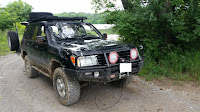A couple of buddies and I took the truck out to test a number of things on the platform. A day of learning if you will. The goals included seeing how the:
- vehicle handled in fresh, wet, messy mud
- tires cleared debris, maintained traction and enabled control;
- vehicle responded with no air lockers, rear only, front and rear;
- winch, cable, remote, tree strap and clevis worked in combination pull a dead vehicle up a gradual slope; and
- land anchor works, pros, cons and general usefulness.
We ran out of day and did not get to the land anchor. It was still a great day. We learned.
- The tires clear out well, grip well and overall provided great control uphill, downhill, through ditches, on ATV trails in the forest and on slippery, muddy roads.
- The air lockers rock. The truck works well in standard 4x4, with rear air locker and with both engaged.
- The 12k lb winch wasn't tapped. One of my buddies pushed the brake to stress the winch a bit more. We didn't tap the potential. Did what it should.
- Same goes for straps, clevis, etc. All worked as expected. No issues. I feel good about them.
- We ran out of day and didn't get to the land anchor. Bummer.
Now, part of the reason we ran out of day was due to losing engine power. We checked the vehicle computer and it told us the platform was having trouble on cylinder eight. So, we replaced the coil and BAM! it picked back up and partied. All of this occurring across about three hours, a visit to two auto parts stores, the garage of one of my buddy's father, as well as, some general wrenching. Still learned. Still had a great time. Friends make the journey enjoyable.
Incidentally, another important lesson: Under-carriage armor is great for protecting the machine. It also collects mud. Even with a power washer, cleaning was measured in multiple hours, across multiple days. We very thoroughly found amazing places to gather mud.
Oh, and did I say we had fun?





















































